Sewing Room Organization: Your Complete Guide
THIS POST MAY CONTAIN AFFILIATE LINKS. PLEASE SEE OUR FULL DISCLOSURE POLICY FOR DETAILS.
Learn how to get your sewing room under control – no matter how many works in progress you have. Quilters, sewers, crafters anyone that loves to create things out of fabric – this sewing room organization guide is for you.
Finally get your sewing room under control, no matter how many projects you’re currently working on. This sewing room organization guide has it ALL!
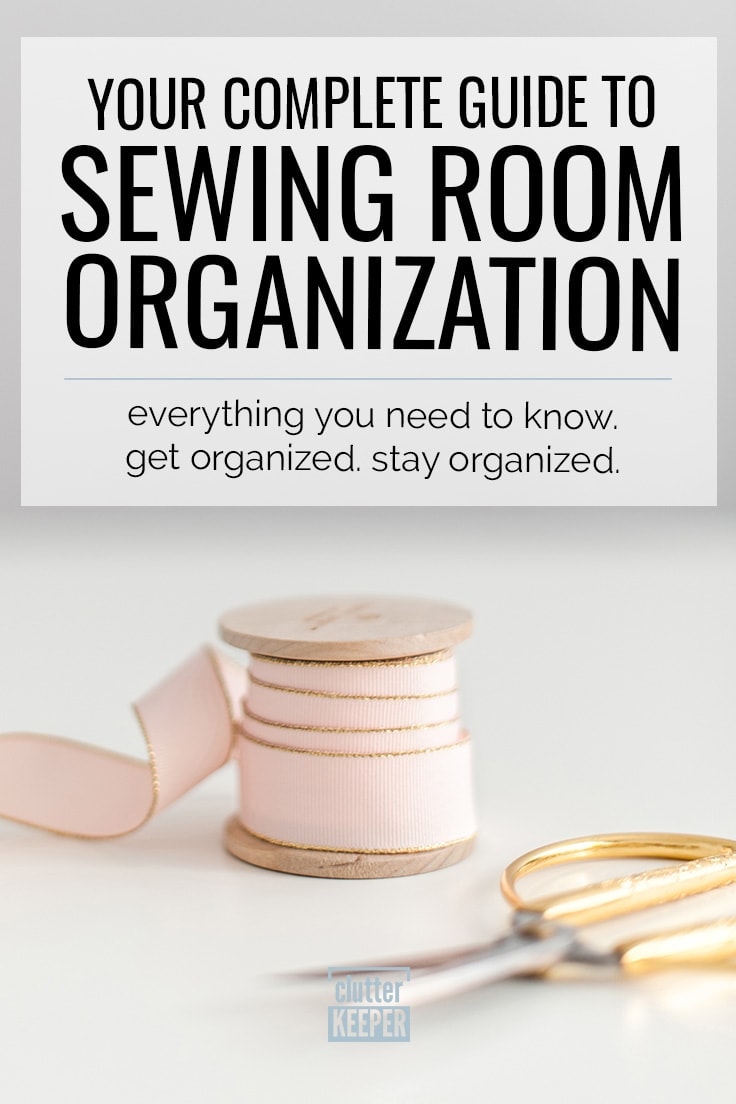
Wondering where to begin? Get our FREE guide, The 30-Minute Organizing Secret, and discover easy ways to overcome the chaos of clutter – even with kids at home!
Sewing Room Organization
When you are sitting in a completely organized sewing room, it just feels right. The creative thoughts will begin to swirl and you’ll be more inspired to create projects.
If your sewing room is messier than it is organized, then this guide is for you.
This guide will show you:
- What a Sewing Room Is
- How to Completely Organize Your Sewing Room
- Prioritize
- Establish Fabric Solutions
- Throw Away Or Donate Used Items
- Establish Workable Zones
- Display Finished Projects
- Sewing Room Hacks
- How to Organize A Sewing Room on A Budget
- Reuse Things from Around Your House
- Remove Unused Items
- Rearrange Furniture
- How to Organize a Small Sewing Room
- Purge
- Prioritize
- Protect
- How to Store Fabric
- Sewing Room Organization Products
- How To Store Apparel Fabric
- Pattern and Notion Storage
What is a Sewing Room?
Before we go too far, let’s answer the most important question of all: what qualifies as a sewing room?
Because let’s face it, not everyone has a large room in which to sew and create.
If you have a corner of your dining room full of fabric scraps and a sewing machine, your dining room is your sewing room.
This guide will help you organize your sewing and creative space – wherever that may be.
As you organize your sewing room, download the Take Back Control reference book. It’s packed with encouragement and easy steps for every room of your house.
Then, when you’re ready to finally organize your sewing room, use the Clear Your Craft Room Toolkit. It’s got checklists, planner pages, printable labels, and MORE!
How to Completely Organize Your Sewing Room
Sewing is one of those hobbies that can literally take over your entire home. You’ll find pincushions in the living room and spools of thread in your bedroom.
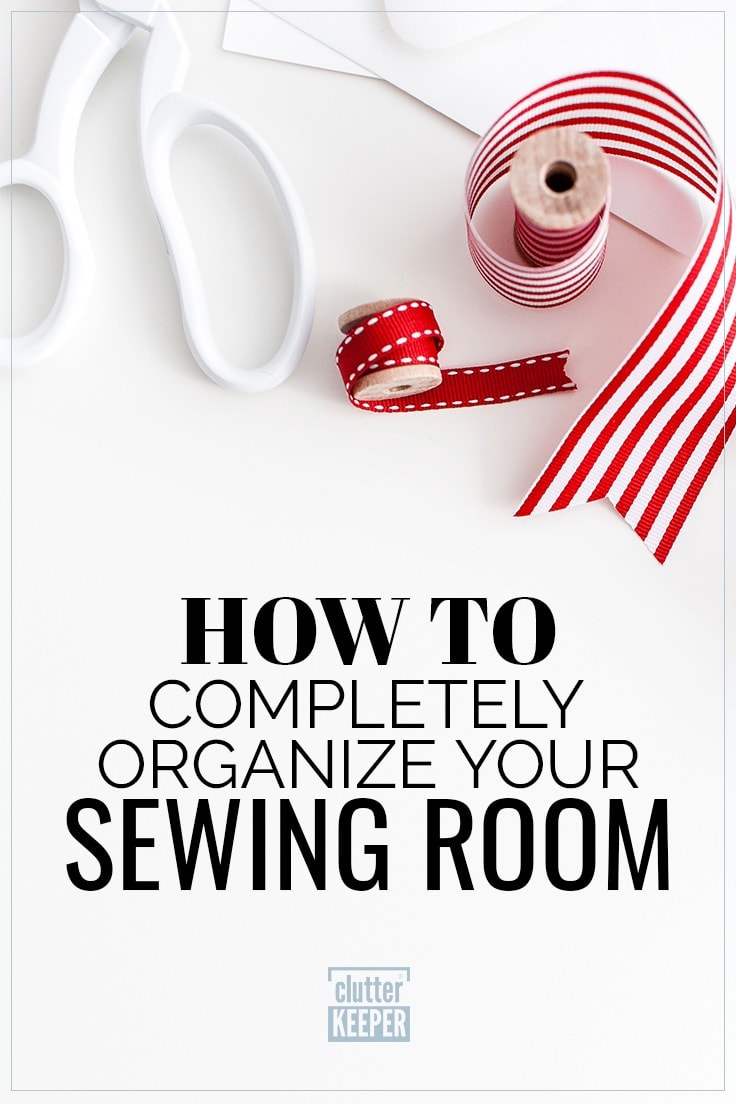
This guide will walk you through every single step so you can have an organized home and a beautiful space in which to create all your works in progress.
Let’s start with the 5 steps to completely organize your sewing room.
1.) Prioritize
The first step is to prioritize your projects.
What are you currently working on? What is the most important? Keep your most important projects out and store the rest away.
Be honest with yourself here. What can you actually accomplish? Don’t try to do too much at once – that will lead to even more disarray and chaos.
Another thing to prioritize – all your sewing supplies and tools. Do you have anything that you don’t use? Donate it or throw it away.
2.) Establish Fabric Storage Solutions
Next, look at all your fabric and supplies and decide how you are going to store it all. Later on in this guide, you’ll see some creative ideas and hacks. See if any of these will work with your space.
3.) Throw Away or Donate Unused Items
The third step is included in every organization guide on Clutter Keeper’s blog. It is always included because it is so important. Only keep what you use and you will discover so much more room than you knew you had.
4.) Establish Workable Zones
After you clear out your sewing room and can see only the projects you are currently working on, you can establish workable zones. Make your space functional. Where will you cut the fabric? Where will you measure?
This is a perfect time to evaluate your furniture as well. Do you need more tables? More lights?
5.) Display finished projects
The final step is the most important. Find a way to display your finished projects. Celebrate your accomplishments and let this motivate you to keep working on your current pieces.
Sewing Room Organization Hacks
Need some fresh ideas and ways to organize all your supplies? Here are 8 totally genius sewing room organization hacks.
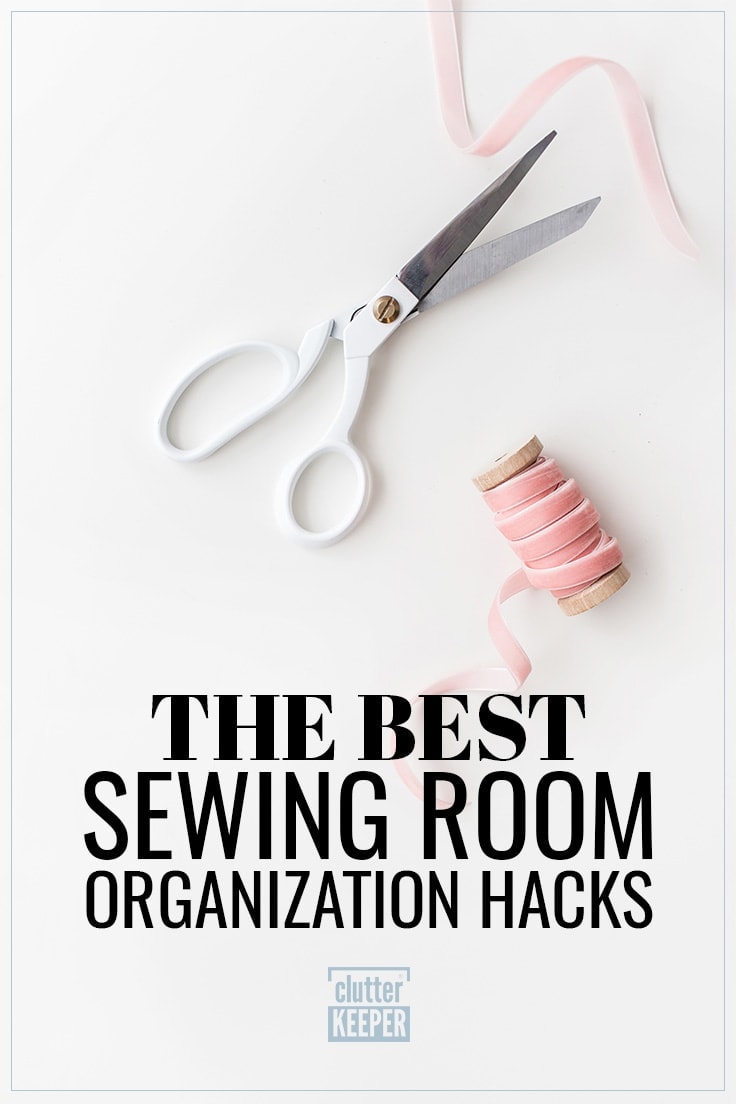
Just for fun – here’s a video showing more hacks that you can use. Most of them are super easy and don’t cost much at all.
1.) Use Binder Clips to Keep Ribbons and Elastics Together
Ribbons, elastic, and ric rak embellishments tend to unravel and mess up a drawer or desktop. Keep them all together with a simple binder clip. It’s easy to use. And bonus – you can use the binder clips to hang them to a peg board on the wall (which is the next hack!).
2.) Use A Pegboard
A pegboard can hold almost everything – from spools of thread to ribbons, to buckets for tools like scissors and measuring tape.
Plus, when you use a pegboard, you can also hang up inspirational messages to yourself and organize it all by color. Oh the possibilities!
3.) Fold Fabric Around A Comic Book Board
A comic book board is a perfect size for wrapping unused fabric. When you are done, it comes out looking just like a fabric shop. So pretty, so organized, so tidy.
What is a comic board? It’s what collectors use to keep their comic books from bending and maintain their mint condition status.
How do you use a comic book board for extra fabric? Follow this easy video:
4.) Glue the Measuring Tape to the Cutting Table
The easiest place to keep your measuring tape is directly on the table – just like at the fabric shop. Glue the measuring tape to your cutting table so you won’t ever lose it.
Plus, it will speed up your cutting time when you have a stationary place to measure your fabric.
5.) Create a Measuring/Cutting Table That Folds Into the wall
This next hack involves creating a table that folds into the wall. This will give you a table that you can use for cutting and measuring, but also something you can fold up when you need more space to sew.
This is a wonderful hack if you don’t have much room to spare.
6.) Stack Threads and Bobbins Together
Never lose a matching bobbin again. Use a small dowel rod for each color of thread and simply stack the matching bobbin on top. It’s a very simple solution and will save you tons of time.
Bonus points if you organize your thread by color.
7.) Use Hanging Organizers
Invest in some high-quality hanging organizers to store your extra fabric, ribbons, and sewing tools so they are always within your view and your reach.
Hang them from the ceiling, on a curtain rod, or even behind the door.
Many organizers can be hacked and used to hold rolls of fabric, measuring tapes, scissors, and patterns. It has tons of zippers and pockets, it’s the perfect organizer.
8.) Store Current Fabric in a Filing Cabinet
The last hack is pretty genius. Fold and store all your fabric in a filing cabinet. The Thinking Closet came up with this smart idea.
It clears up a lot of space and you can see all your fabric just by opening the drawer. So easy!
How to Organize a Sewing Room on A Budget
You don’t need to have a ton of money or all the organization products to have a stunning sewing room. Here are some valuable tips that will give you a super clean space in which to create – for next to nothing.
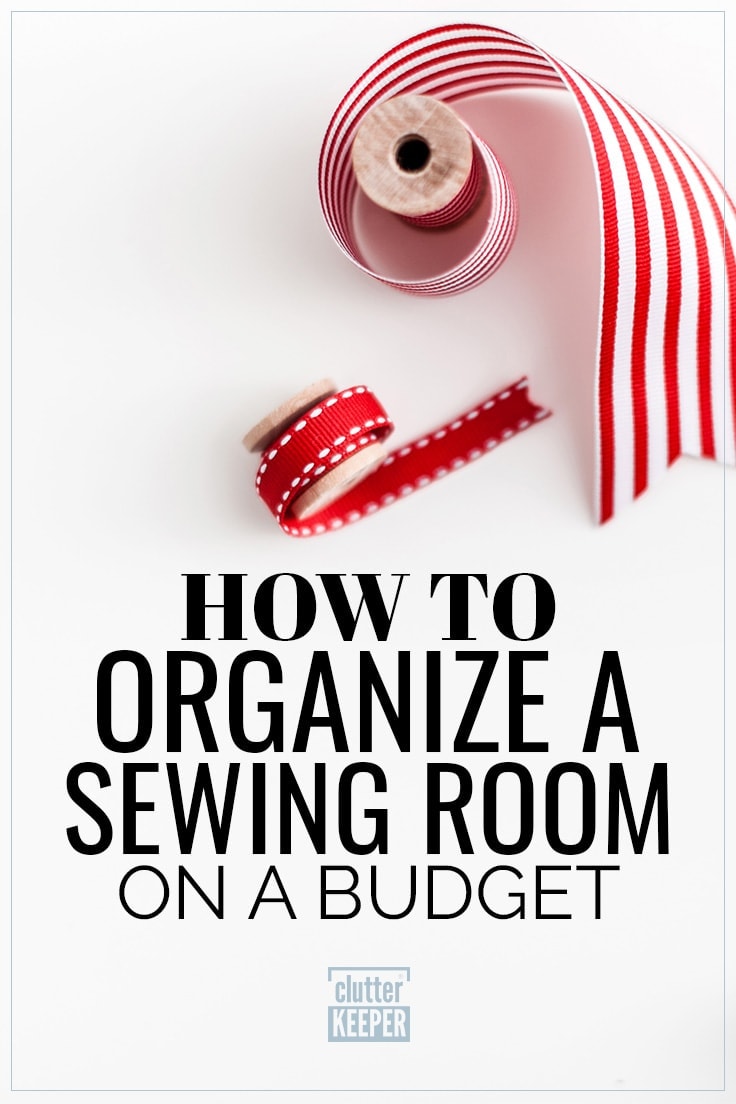
1.) Reuse things from around your house
Start out by going around your house and finding things that can be used as storage. Don’t go out and spend money on a tub or bin when you have some shoe boxes you can use instead.
Here are some ideas to get you started:
- Use coffee cups to hold sewing tools
- Erasers can be pin cushions
- Bathroom towel rack can hold ribbons and fabric
- Filing cabinet for fabric storage
- Egg carton or ice cube tray for tiny embellishments like sequins
2.) Removing Unused Items Will Create More Space
It doesn’t cost a thing to remove things you don’t use and it makes such a huge difference.
Then, make a goal of not buying any new things or starting any new projects until a few of them are completed. Yes, that’s super difficult, but it can help you keep your sewing room organized.
3.) Rearrange Furniture
Finally, try rearranging your furniture. This doesn’t cost anything at all and can make a noticeable difference. As you move things around, keep in mind how you will move in the room. Give yourself lots of walking and working space.
How do you organize a small sewing room?
If you have a really tiny room for sewing, you need to make the most out of every inch. There are three P’s to organizing a small sewing room: Purge, Prioritize, and Protect.
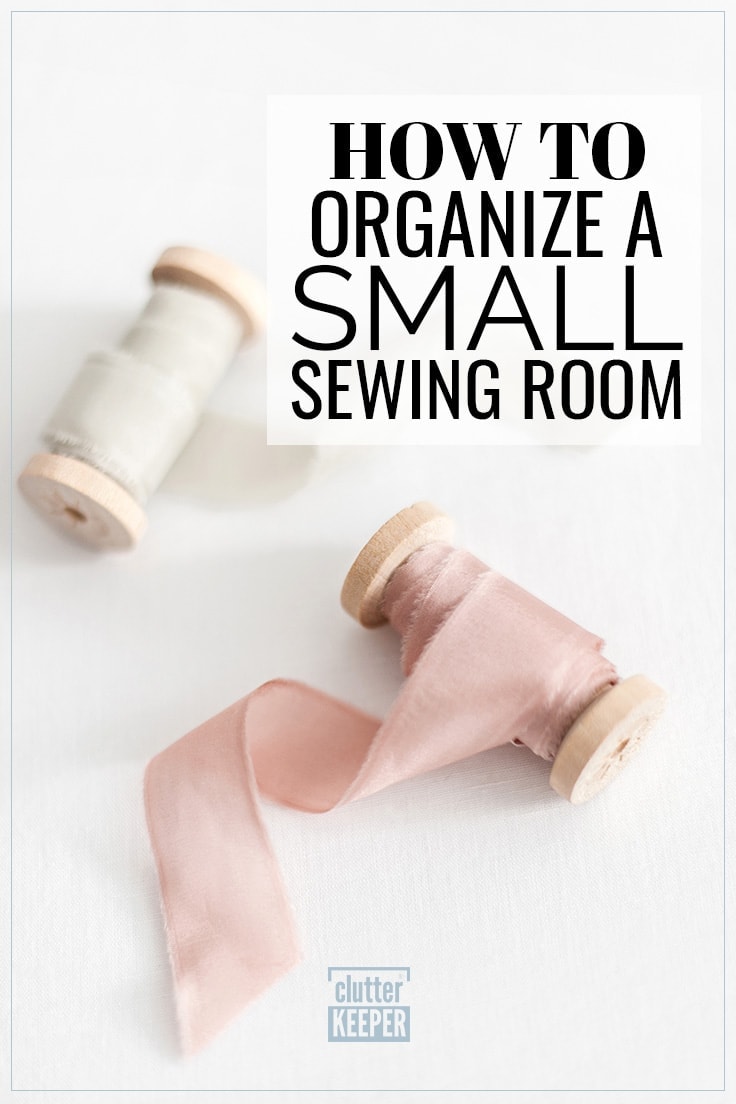
1.) Purge
Yes, letting go of pieces of fabric or even works in progress that will never be completed is super difficult. But it will make a lot of difference if you don’t have very much space in which to work.
In a small sewing room, you don’t have extra room to keep things you don’t need and won’t use in the near future.
Since it can be pretty painful to let go of future “maybe someday” projects, try to store them somewhere that is out of the way. Put them in a tub with a lid and label it so you can find it later.
2.) Prioritize
Only keep things in your sewing room that you are using currently. Prioritize projects based on how important they are for you to finish. This is especially important if you are a “multiple crafts at once” kind of sewer or seamstress.
If it helps, you can also keep a paper list of all your projects so you can see them all at once and (try to) refrain from starting new ones until they are finished.
3.) Protect
Protect the organization and tidiness of your room by establishing storage systems you can maintain.
Test them out. Take your tools and fabric out and put them back in. Is it easy? Or is it awkward, something you won’t want to do every day?
Create a storage system that sets you up for success. Make it so you can tidy up the room at the end of the day, no matter how tired you are.
How do you store fabric in a sewing room?
What are the most common things that need to be stored in a sewing room? Fabric and thread.
Let’s talk about the fabric.
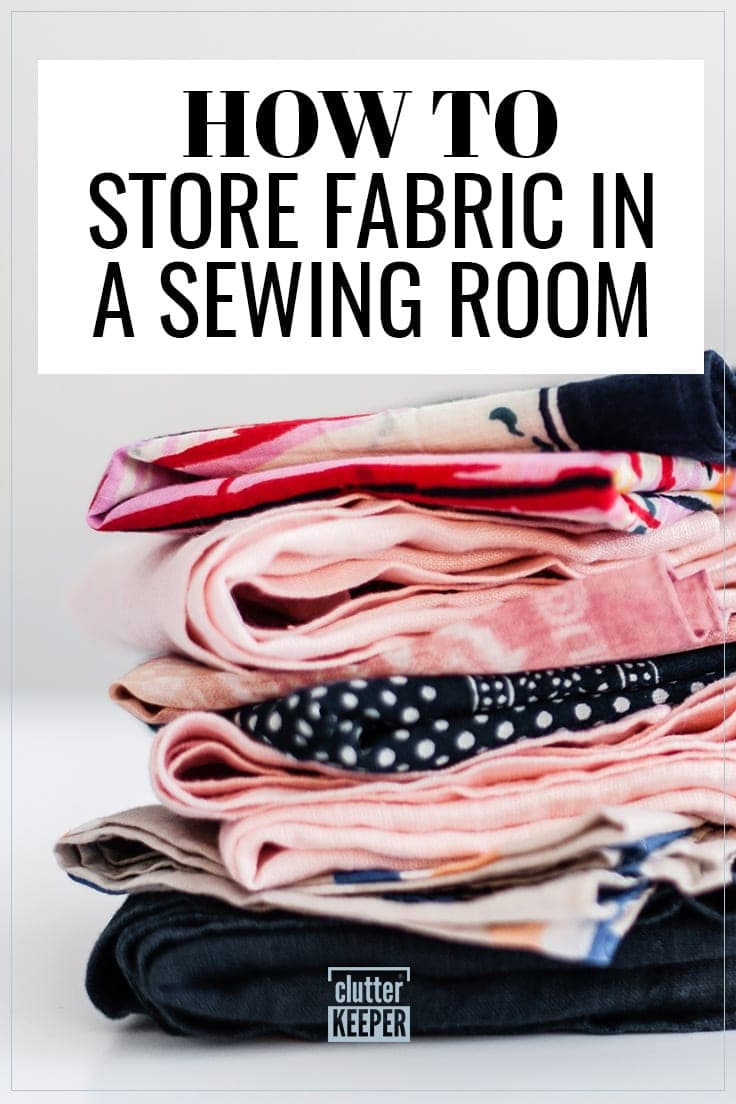
We already covered a few fantastic ways to store your fabric. There are so many more creative ways that will show off your stash but also keep it put away until you need it.
- Filing Cabinet – Keep your fabric on file folders in a filing cabinet.
- Standing Up – Store your fabric like the fabric shops
do, use foam boards to wrap them - KonMari Method – Fold your fabric standing up in drawers so you can see every single piece.
- Matching Baskets – put the fabric in baskets that match by color
- In a Cabinet – Put your stash behind doors. This one has glass so you can still see inside.
Sewing Room Organization Products
Now that you know how to organize your sewing room, let’s check out some must-have products that will keep everything in place.
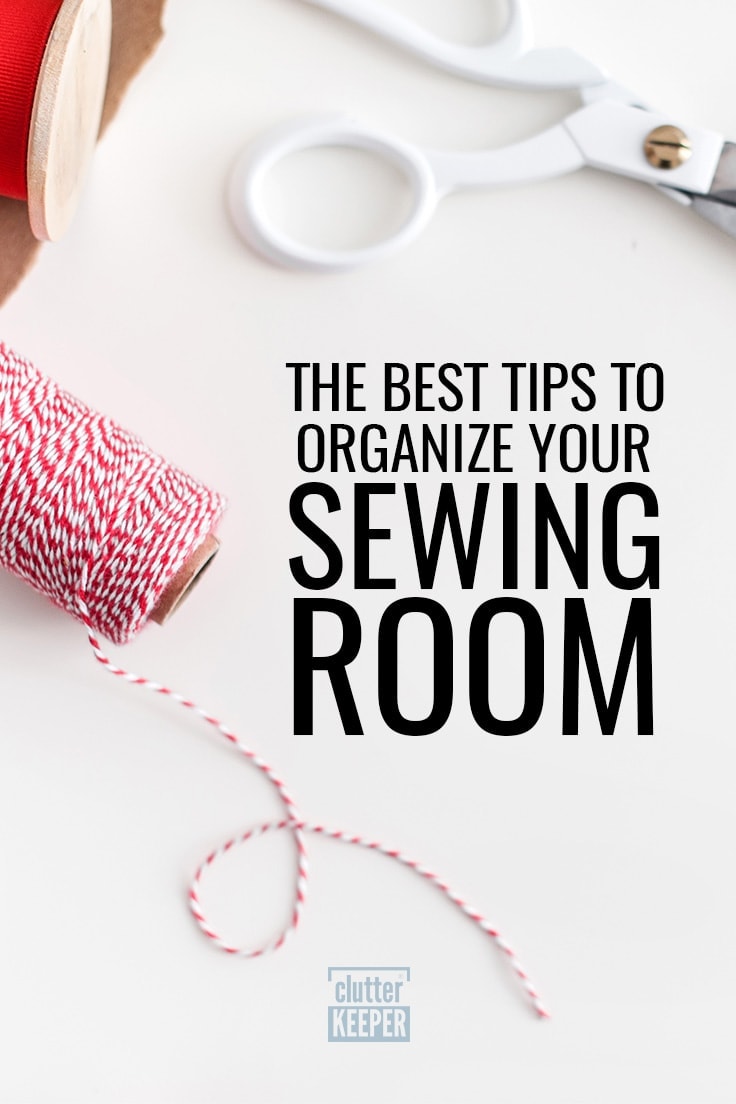
These are just a few of the wonderful ideas and products out there, but we honestly think they are the best. Every sewing area needs every single one of these things.
1.) Storage Bags
Sort through all the projects that you can’t complete soon and store them in a zippered storage bag.
Choose one with lots of room and that can fit under the bed, inside a closet, or neatly stacked in a corner.
2.) A Gift Wrap Hanging Organizer
Another fantastic tool for organizing everything is a gift wrap hanging organizer. Many of these can be used to store so much more than just wrapping paper.
3.) Sewing Cabinet
Every single sewing room needs some sort of sewing cabinet. Find one that fits in your room and can help you keep everything put away where it goes.
If you have a small space, you might want a rolling sewing cart that can move around the room.
There are also complete sets – sewing table and cabinet all in one – that fold up when you are not using them.
4.) Giant Pegboard
The next thing every sewing room needs is a giant pegboard. As you read earlier, you can use these for everything from decorations, to hanging up buckets for small, loose tools and accents.
Measure your wall and buy the size that will hold everything and fit in your space at the same time. There are a variety of sizes available.
5.) Wire Baskets
Next, if you are going to store your fabric in baskets, choose wire baskets. These are the best for storing fabric because you can see into them easily and find the color/pattern you need quickly.
6.) Spice Rack
Finally, every sewing room needs a spice rack to hold the spools of thread and current-project supplies. The photo below has a spice rack on the wall.
For a little extra fun, you can paint the spice rack to match your room’s theme.
How To Store Apparel Fabric
When you store your apparel fabric, there are quite a few things you need to keep in mind. You need to store by project type, keep your fabric wrinkle-free, and store your fabric after it is cut.
Store by project Type
Use any of the ideas above but keep your projects together. The best way to store apparel fabric is on magazine boards. After you wrap the fabric around the magazine board, store the same types of projects together.
Keep your summer apparel fabric together and place the winter apparel fabric either on another shelf or in another drawer.
Keep apparel Fabric wrinkle-free
A magazine board will also keep your fabrics wrinkle-free too. Mimic the way fabric shops store their fabric too, wrapped around a bolt.
How to store works in progress
Keep your fabrics with the patterns and notions all in the same area. Either put the patterns in a bag and attach them to the fabric with pins or put them all in a large bag together.
Pattern and Notion Storage
Store patterns in a way that makes them easy to find when you need them. Try any of these ideas and use the ones that fit your space and lifestyle best.
- Digital Files – If you have digital files of sewing patterns, back them up to a cloud storage.
- Magazine Holders – Put each pattern in a plastic bag. Then, put these bags in magazine holders. Label the outside with the type of patterns that are inside.
- 3-Ring Binders – Store your patterns in plastic page protectors and put them in binders. Keep the same kind of patterns together.
- Large Envelopes In A Tub – Write the name of the pattern on the envelope and store the same kind of patterns in a file box together. Label the outside of each box.
- Zippered Bags – Protect your sewing patterns inside zippered storage bags. Then, store them in a vertical file or filing cabinet.
How To Store Notions
Sewing notions can be so frustrating to keep organized. They are tiny which makes them get lost easily.
Instead, use a tackle and tool box to store the tiny sewing supplies like thimbles and needles.
Another easy solution is to sort them into small glass jars. Label the jars so you know what’s inside. Spice jars are the perfect size for buttons, needles, and other sewing supplies.
Finally, one of the most popular ways to store small sewing supplies is in a plastic cosmetics drawer case.
Creativity and Organization Can Work Together
A stunningly organized sewing room will actually enhance and spark more creativity. All you need is some time to sort through everything and a few supplies to give everything a home.
Have fun with it! Organize everything by color. Create displays and decorate your sewing room so it makes you smile when you walk in.
Struggling to get motivated? Sign up to get our FREE guide, The 30-Minute Organizing Secret, and discover easy ways to overcome the chaos of clutter – even with kids at home!
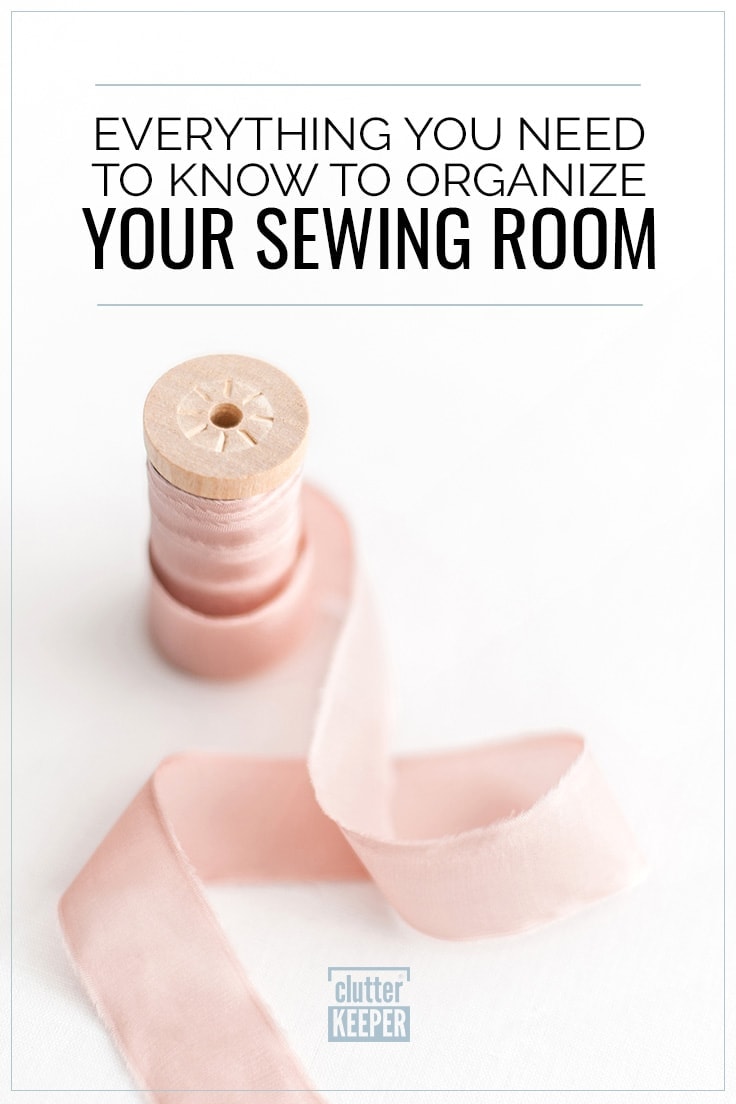
More Home Organization Articles
Here are some more guides and articles to help you organize other areas of your creative life.
- Craft Room Organization – Do you love other arts and crafts projects too? Learn how to keep it all organized with this guide.
- Bookshelf Display Ideas – Books and bookshelves can be so stunning. Here are some fresh ideas to change things up.
- How to Organize Office Supplies Like a Pro – Keep all your office supplies in their place with these essential tips.
- Yarn Organization: Guide To Organizing Knitting & Crochet Supplies – Organizing your yarn stash is easy with these tips.


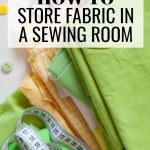


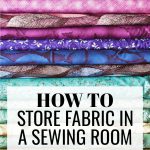

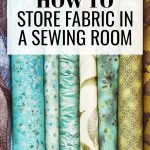

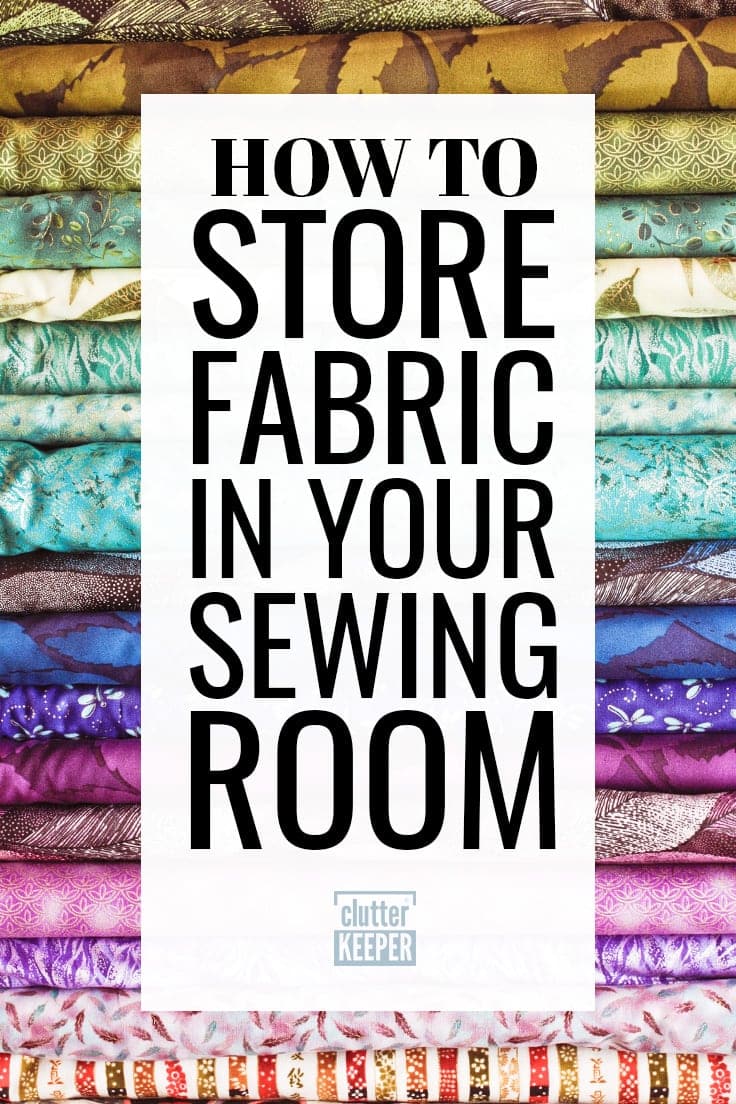

Where did you get those wood spools
Hi Leanne, Do you mean the wood spools used in the graphics? If so, these wooden spools are very similar? Hope you were able to find some great organizational tips! Thanks for stopping by!
Best wishes,
Robin for Clutter Keeper®
Everyone seems to think that everyone who sews is a quilter or only buys quilting fabric. I have a lot of fabric, only about 10% of which is quilting cottons. No one offers ideas for storing apparel fabric when organizing a sewing room. I feel left out.
I so ABSOLUTELY, Completely agree with you, Louise!! I need ideas for pattern and notion storage, also.
Another way to store fabric is to do to local fabric store and ask for the empty fabric bolts. Wrap material on them and store in a file cabinet or shelf.
That’s a great idea, Edie! Thanks so much for sharing it with us.
Best wishes,
Carrie
Clutter Keeper
Here in the UK our homes tend to be much smaller than in the US and our sewing areas have to jostle side by side with many other uses .I am lucky to have a room that has a sewing area alongside my study. However I discovered when sorting my fabric and yarn stash and reorganising the space that we had a clothes and carpet moth infestation !
I now keep my fabrics and yarns in plastic mothproof bags having previously discarded them for more eco gauze bags ! ( They ate through these !)
So if you have large collections of natural fabrics and yarns or a cashmere sweater collection look out for the tiny moths !
I agree with one of the other comments, it seems like everything if for quilter. I sew clothes. And stuffed animal. I am a fabrichalic. I have an overlock that uses lots of thread. A peg Board doesn’t work. Here is how I keep my thread organized. I have plastic bins about file folder size. When I buy thread I put the same color in a small zip lock baggies then in the bin it goes. No tangled thread easy to find. Bins are divided by the color wheel. My cutting table has a shelf under it so it’s easy access.
I think I’ll try the core form board to rap my fabric. I tend to buy when I see something I like.
I like to sew for dolls. I recently got very tiny zippers, buttons, snaps and Velcro. Your cosmetic box idea gave me inspiration on how to store them. Thank You for sharing !